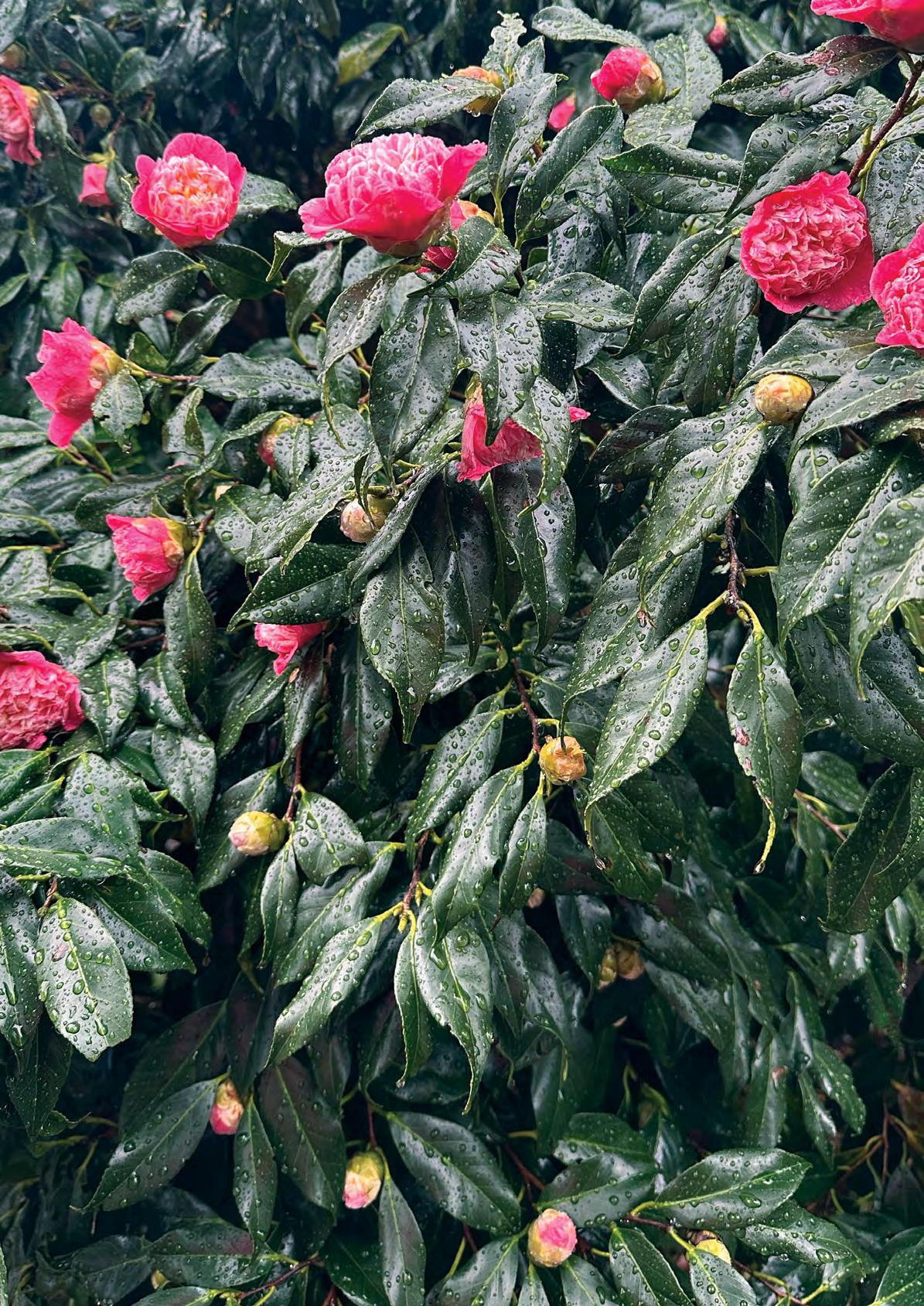
5 minute read
IN THE LAND OF CAMELLIAS
A visit to the International Camellia Society’s Congress in Japan gave fascinating insights into this much-loved bloom, from perfectly preserved Samurai gardens to wild camellia forests, writes Marion Whitehead, Supervisor Ornamental Gardens and Nursery Mount Tomah.
GARDENS

Japan is the home of the camellia. With over 40,000 cultivars of Camellia japonica derived from native Japanese species, ancient tea ceremonies centered around matcha made from Camellia sinensis leaves, and the Samurai revering the Higo Camellia for its symbolism of strength, the flower is deeply rooted in Japanese culture.
In March, thanks to the Clive and Lorna Backhouse scholarship, Sophie Daniel, Manager of Interpretation and Placemaking, and I travelled to the International Camellia Society’s Congress in Japan. Once there we immersed ourselves in all things camellia, presented on behalf of the Botanic Gardens, and brought new insights back to our own Living Collections.
We began our journey in Kanazawa, where the Congress was officially welcomed to Japan. One of the most memorable moments there was visiting the preserved home of a Samurai, quietly nestled behind the city streets. The house was designed entirely around its garden – every window offering a view into a small, enclosed oasis hidden behind wooden fences. Featuring flowing water, a restrained plant palette including camellias, and a floor of lush moss, it was a living dreamscape. This quiet, green refuge reminded us of the profound role gardens played in the lives of Samurai – as spaces for reflection, discipline, and harmony with the natural world.
A royal welcome
The main Congress featured fascinating papers on groundbreaking genetic work on camellias globally, storied cultivars across Europe, and the many economic uses of the humble Tsubaki. I had the honour of presenting on behalf of the Botanic Gardens of Sydney, sharing our work collating camellias from across Australia and designing bespoke landscapes to showcase them. The cultural significance of camellias in Japan became particularly evident when Her Imperial Highness,
Princess Takamado, addressed the Congress at our welcome dinner. She spoke eloquently of the mejiro – small silver-eye birds – that pierced tiny holes in her camellia flowers as they sipped nectar, resulting in imperfect blooms for her photography during the 2020 lockdown. Her affectionate observation struck a universal chord, connecting the ancient homeland of the camellia to every delegate present.
On behalf of our Gardens, Sophie and I gifted the Princess a pen crafted from turned Wollemi Pine timber, explaining the tree’s ancient lineage and conservation story. A keen conservationist herself, she was captivated. We assured her the tree had not been felled for the pen, but had died of natural causes.
Exploring wild camellia forests
From Tokyo, we travelled by speedboat to Izu Ōshima, a small volcanic island that last erupted just 35 years ago. The island’s plants rise from dark volcanic ash, and its forests boast three million wild Camellia japonica. Izu Ōshima is also home to three International Camellia Gardens of Excellence within just 90 square kilometres – the highest density of such recognised gardens in the world.
On arrival, our group was quickly ushered to the wild camellia forest at the island’s summit. Sadly, we were allowed only 10 minutes among the towering, ancient camellias. While the Botanic Gardens of Sydney holds a range of beautiful, cultivated camellia varieties, I’m captivated by wild forests where the plants grow freely. Determined to see more, I got up before dawn the next day and ran five kilometres back up the volcanic slopes to return to the forest.
Arriving as the first light broke, I was enveloped in the dawn chorus of unfamiliar birds, the forest floor blanketed in fallen pink flowers, and the gnarled trunks of camellias reaching skyward. I found myself engaging in shinrin-yoku, the Japanese practice of




Bottom right: Camellia japonica 'Momoiro-bokuhan' in Tsubaki-Hana-Garden
Photos: Marion Whitehead forest bathing – calmly observing nature with all the senses. The run back down was equally inspiring, flanked by wild drifts of mondo grass, clusters of bright red aucuba berries, and the tiny yellow lanterns of earlyblooming Stachyurus praecox. That evening, we were treated to a local opera performance organised just for the members of the Congress – an adaptation of La Traviata, ‘The Lady of the Camellias’ – which featured a magical camellia oil that saves the heroine’s life.
Temples and sacred deer
Our final stop was Nara, Japan’s first ancient capital over a millennium ago. Famous for its bowing deer, grand temples, and Wakakusayama – the mountain burned each spring to honour the dead and mark the changing seasons – Nara offered a reflective end to our journey. We were fortunate to be guided by Hashimura Kōei, the 224th Chief Abbot of the Tōdai-ji Temple, and his wife. They led us to three ancient camellias gracing the temple grounds, one of which had a grafted scion from a 300-year-old plant. The rootstock was estimated at 500 years old, meaning the genetic material had endured in that sacred place for more than 800 years. I was deeply moved by this living symbol of horticultural continuity, especially knowing our own nursery now uses the same grafting techniques to preserve camellias for the future.
Our trip was a rare opportunity to witness the cultural and botanical depth of camellias in their country of origin. From imperial ballrooms to wild volcanic forests, and ancient temples to local operas, the camellia is revered not just as a flower, but as a symbol of heritage, resilience and renewal. As we continue to care for and share the camellia collection at the Botanic Gardens of Sydney, these experiences will shape how we tell its story – rooted in ancient tradition, but blooming into a vibrant global future.











